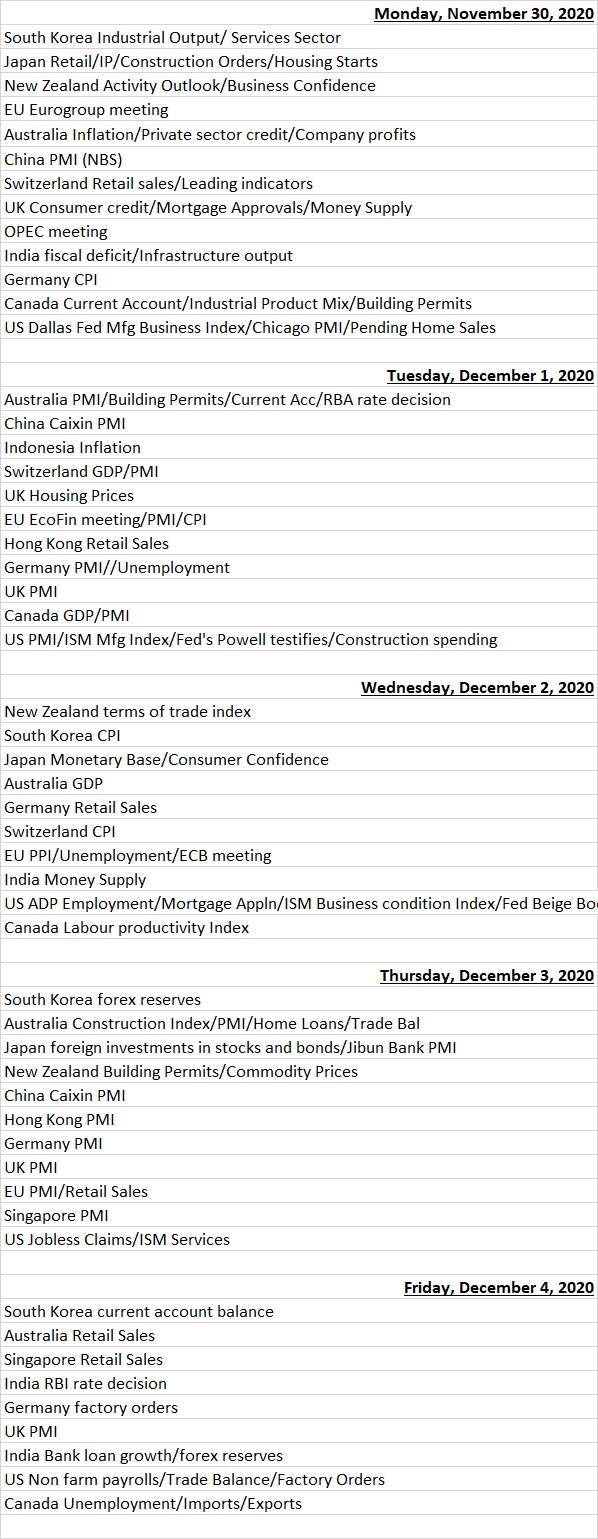(ATF) Economic events
Financial markets should extend their rally in the week ahead as investors price in the US presidential transition and as the positive news on the vaccine front continues to flow, although the surge in infections remains a dampener.
Central bank comments are also fuelling this optimism with the minutes of the October European Central Bank meeting released last week, reinforcing expectations of further stimulus next month and after People’s Bank of China deputy governor Liu Guiping said at a conference that China’s finance sector should open up further to support the “dual circulation” economic strategy and mitigate risks in the industry.
On the economic data front, purchasing managers’ index readings, some third-quarter gross domestic product releases and consumer price indices feature in a crowded calendar. Investors are also checking to see if there will be any signs of movement on the fiscal side to provide support to the world’s biggest economy.
“Should politicians fail to step up, then expectations will build that the Federal Reserve will feel compelled to try to offer some support through extra liquidity injections and potentially more quantitative easing,” said ING economists James Knightley and Bert Colijn in a note.
“Nonetheless, the Fed will again emphasise this is not going to generate meaningful demand. It is more about trying to shore up confidence until the Covid-19 vaccines are released.”
The most eagerly awaited data point would be the non-farm payroll in the United States with November likely to be the seventh straight month of jobs gains. The consensus is for non-farm payrolls to rise by around 600,000, which would be strong by historical standards but represents only a modest recovery when looked at in the context of the fall seen at the height of the pandemic, and would leave employment still around 9.5 million lower than the pre-pandemic peak, said Siân Jones, economist at IHS Markit.
In Asia, economic recovery in the fourth quarter will be gleaned from the November PMI releases in China, Australia and Japan and trade updates in Malaysia and South Korea. Rate decisions in Australia and India will be known while markets will also closely track developments in the trade spat between Australia and China.
“With China leading the global recovery, both NBS and Caixin surveys will be especially closely scrutinised for signs that the Chinese growth momentum was sustained midway through the fourth quarter,” said Bernard Aw, principal economist at IHS Markit.
Fund flows
In the week to November 25, fund flows indicated investors had extended their risk exposure with more than $100 billion flowing into global equity funds in the past three weeks – the highest in history. Jefferies analyst Kenneth Chan wrote in a note that emerging markets equity interest remained robust, and that in fixed income credit (+$4.1 billion) and EM bonds (+$3.3 billion) led inflows. This meant that safe havens lost their lustre with gold-linked funds reporting a flat week.
“Reach for yield appears to be in vogue,” said BofA Securities analysts in a note. “Investors over the past weeks have been moving up the yield chain reaching for better carry via EM debt and high-yield bonds. IG and government bonds have underperformed, with the later suffering a small outflow last week,” they said, adding that recent flow trends were a harbinger for next year.
“We think investors will be reaching for beta and yield predominately via HY and EM debt funds,” they said. “A brighter growth outlook in 2021 should bode well for high beta risk assets. Conversely, current IG valuations and relatively low yields point to underperforming IG funds vs. their HY peers.”
Economic data calendar

Last week’s rating changes

























